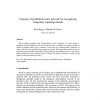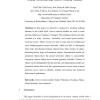21 search results - page 1 / 5 » Discriminating Animate from Inanimate Visual Stimuli |
IJCAI
2001
13 years 6 months ago
2001
From as early as 6 months of age, human children distinguish between motion patterns generated by animate objects from patterns generated by moving inanimate objects, even when th...
IJON
2002
13 years 4 months ago
2002
Much evidence indicates that discrimination of the familiarity of visual stimuli is dependent on the perirhinal cortex of the temporal lobe. A stimulus can become familiar to anim...
HUMO
2000
Springer
13 years 8 months ago
2000
Springer
Seeing biological motion is very important for both humans and computers. Psychophysics experiments show that the ability of our visual system for biological motion detection and ...
AROBOTS
2002
13 years 4 months ago
2002
If we are to build human-like robots that can interact naturally with people, our robots must know not only about the properties of objects but also the properties of animate agent...
IJON
2002
13 years 4 months ago
2002
: In this paper we describe a method for tracking walking humans in the visual field. Active contour models are used to track moving objects in a sequence of images. The resulting ...


